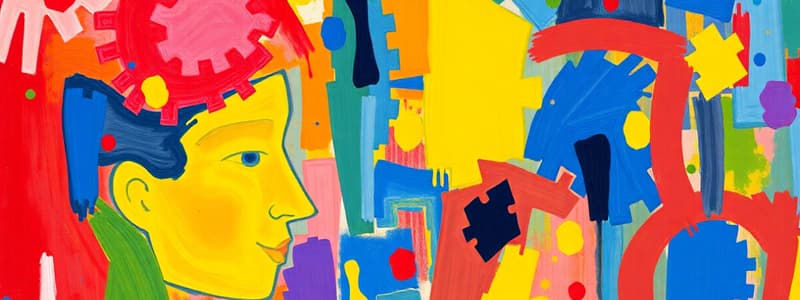Podcast
Questions and Answers
Autism is characterized by affecting which area(s) of development?
Autism is characterized by affecting which area(s) of development?
- Physical mobility and coordination
- Verbal and nonverbal communication, and social interaction (correct)
- Verbal communication only
- Nonverbal communication only
There is a known cure for autism.
There is a known cure for autism.
False (B)
Around what age is autism typically diagnosed?
Around what age is autism typically diagnosed?
4
Individuals with autism may exhibit __________ movements such as hand flapping or rocking.
Individuals with autism may exhibit __________ movements such as hand flapping or rocking.
Match the characteristics with the cues they indicate for recognizing autism:
Match the characteristics with the cues they indicate for recognizing autism:
Which of the following is an example of a 'restricted, repetitive behavior' as it relates to diagnostic criteria for Autism Spectrum Disorder?
Which of the following is an example of a 'restricted, repetitive behavior' as it relates to diagnostic criteria for Autism Spectrum Disorder?
Autism only affects a child's educational performance; it has no impact on social interactions.
Autism only affects a child's educational performance; it has no impact on social interactions.
Besides autism what are other common co-morbid conditions that can also be present?
Besides autism what are other common co-morbid conditions that can also be present?
Autism was first dicovered by __________ __________ in 1943.
Autism was first dicovered by __________ __________ in 1943.
What are the core deficit areas associated with autism?
What are the core deficit areas associated with autism?
Symptoms of autism typically become evident after the age of 10.
Symptoms of autism typically become evident after the age of 10.
Before 2013, what other conditions were considered part of the Autism Spectrum?
Before 2013, what other conditions were considered part of the Autism Spectrum?
The DSM-5 diagnostic criteria for autism require that a person demonstrates persistent deficits in social communication and interaction, along with at least two types of __________ repetitive behavior.
The DSM-5 diagnostic criteria for autism require that a person demonstrates persistent deficits in social communication and interaction, along with at least two types of __________ repetitive behavior.
If an individual with autism has limited interests, abstraction difficulties, and challenges in typical social situations what challenge would this lead to?
If an individual with autism has limited interests, abstraction difficulties, and challenges in typical social situations what challenge would this lead to?
Evidence-based and individualized interventions are not effective types of treatments since all individuals with autism respond similarly to treatments.
Evidence-based and individualized interventions are not effective types of treatments since all individuals with autism respond similarly to treatments.
Flashcards
Autism Definition
Autism Definition
A developmental disability affecting communication and social interaction, impacting a child's educational performance, along with repetitive activities, resistance to change, and unusual sensory responses.
Autism: Restricted Behaviors
Autism: Restricted Behaviors
Symptoms can manifest as repetitive motions, fixated interests, insistence on sameness, and hyper- or hypo-reactivity to sensory input.
Facts About Autism
Facts About Autism
Discovered by Leo Kanner in 1943. Occurs in 1 in 36 children. Symptoms evident usually between ages 2-5. Cause is unknown. Occurs in all races and ethnicities.
Challenges with Autism
Challenges with Autism
Signup and view all the flashcards
Autism Treatments
Autism Treatments
Signup and view all the flashcards
Key Points of Autism
Key Points of Autism
Signup and view all the flashcards
Autism Spectrum Disorder
Autism Spectrum Disorder
Signup and view all the flashcards
Four Restricted/Repetitive Behaviors
Four Restricted/Repetitive Behaviors
Signup and view all the flashcards
Important facts of Autism
Important facts of Autism
Signup and view all the flashcards
Common Co-Morbid Disorders
Common Co-Morbid Disorders
Signup and view all the flashcards
Study Notes
- Autism is a developmental disability affecting verbal and nonverbal communication, social interaction, and educational performance.
- Other characteristics include; repetitive activities, stereotyped movements, resistance to change, unusual response to sensory stimulus, routine orientation and lack of social awareness
Facts about Autism
- First discovered in 1943 by Leo Kanner.
- Occurs in 1 in 36 children, according to the CDC data.
- There has been a 317% increase since 2000.
- 1 in 45 adults have autism.
- It is shown to be 4 times more prevalent in boys than girls.
- Symptoms are evident between ages 2-5.
- There is no known cause or cure.
- It occurs in all races, ethnicities, and social groups,
The Autism Spectrum Until 2013
- Included Autistic Disorder (AD), Asperger’s Disorder (AS), Pervasive Developmental Disorder Not Otherwise Specified (PDD-NOS), Rett’s Syndrome and Childhood Disintegrative Disorder (CDD).
Autism Spectrum Disorder Diagnostic Criteria
- Per DSM-5 there must be persistent deficits in social communication and interaction demonstrated in 3 areas
- Individuals must display at least two of four types of restricted repetitive behaviors
3 areas of social communication deficits include:
- Social Emotional Reciprocity.
- Nonverbal Communicative Behaviors.
- Developing, Maintaining , and Understanding Relationships.
4 types of restricted repetitive behaviors include:
- Stereotyped or repetitive motor movements.
- Insistence on sameness.
- Highly restricted, fixated interests.
- Hyper- or Hypo-reactivity to sensory input.
Diagnosis of Autism
- Usually around the age of 4, or often diagnosed as a developmental delay.
- Diagnosis is made by a qualified professional using a variety of information.
- It is important to test for differential diagnosis or co-morbidities.
Common Co-Morbid Disorders/Diagnoses include:
- ADHD.
- Intellectual Disability (ID).
- Obsessive-Compulsive Disorder (OCD).
- Learning Disability (LD).
- Anxiety.
- Bipolar Disorder.
- Sensory Integrations Disorder.
- Medical Complications such as seizures.
Recognizing Autism
- Important inlcude looking for communication, behavioral, and social cues
Challenges
- Communication deficits and intense preoccupations lead to very challenging behaviors.
- Limited, repetitive interests make it difficult to engage individuals in a variety of conversational topics.
- Limited interests and difficulty with abstract thinking make abstract thinking hard for individuals to be successful in traditional social environments.
Treatment and Interventions
- Aim to reduce symptoms that interfere with daily functioning and quality of life.
- Can occur in any environment.
- Includes multiple types of interventions.
Key points
- Autism is complex and highly variable.
- Core deficits include social communication and repetitive behavior.
- Comorbid conditions like ID, behavioral issues, and/or psychiatric disorders may be present.
- Evidence-based and individualized interventions are most successful.
Studying That Suits You
Use AI to generate personalized quizzes and flashcards to suit your learning preferences.



